| Author |
Message |
Jack W. Englund

|
 Posted: Thu 25 Mar, 2010 2:02 pm Post subject: Validity Of Scot Dirks Being Made From Broken Swords? Posted: Thu 25 Mar, 2010 2:02 pm Post subject: Validity Of Scot Dirks Being Made From Broken Swords? |
 |
|
Saw this by a "SUPPOSED" Expert . "the True Highland Scottish Dirk was made from broke Sword Blades" He gave no dates or other Evidence. I have Also heard this being "touted" as "FACT"
I ??? this, as I do Know that Many of them where NOT. But was there a "TIME" when this held "True" for the MAJORITY carried ??
Jack.
|
|
  |
 |
|
Allen Reed
Location: Northwest, IL Joined: 19 Apr 2004
Posts: 78
|
 Posted: Thu 25 Mar, 2010 2:15 pm Post subject: Re: VALIDITY OF SCOT DIRKS BEING MADE FROM BROKEN SWORDS Posted: Thu 25 Mar, 2010 2:15 pm Post subject: Re: VALIDITY OF SCOT DIRKS BEING MADE FROM BROKEN SWORDS |
 |
|
| Jack W. Englund wrote: | Saw this by a "SUPPOSED" Expert . "the True Highland Scottish Dirk was made from broke Sword Blades" He gave no dates or other Evidence. I have Also heard this being "touted" as "FACT"
I ??? this, as I do Know that Many of them where NOT. But was there a "TIME" when this held "True" for the MAJORITY carried ??
Jack. |
I have seen pictures of dirks made from sword blades. Let me see if I can find the sources and post them here for you.
Allen
|
|
   |
 |
|
Lin Robinson
|
 Posted: Thu 25 Mar, 2010 2:46 pm Post subject: Posted: Thu 25 Mar, 2010 2:46 pm Post subject: |
 |
|
I think the statement is extreme, but some dirks were indeed made from cut down sword blades. And, of course, the rest were made with purpose-built blades.
Who is this "expert" on all things Scottish?
Lin Robinson
"The best thing in life is to crush your enemies, see them driven before you and hear the lamentation of their women." Conan the Barbarian, 1982
|
|
  |
 |
Christopher Gregg

|
 Posted: Thu 25 Mar, 2010 2:51 pm Post subject: Posted: Thu 25 Mar, 2010 2:51 pm Post subject: |
 |
|
Some certainly were, but from the early 1600's to the late 1700's, when the dirk was a viable military weapon, most "production" dirks were made from imported or locally forged blades. I know that during the risings when weapons importation/possession was restricted, some dirks were mounted with broken or cut down sword blades, since these were available. I don't think the best dirks would have been mounted with a worn out, beat up sword remnant, and the better quality ones I've seen in museum collections have obviously purpose built blades, some very nicely done indeed.
Christopher Gregg
'S Rioghal Mo Dhream!
|
|
  |
 |
|
Lin Robinson
|
 Posted: Thu 25 Mar, 2010 3:10 pm Post subject: Posted: Thu 25 Mar, 2010 3:10 pm Post subject: |
 |
|
| Christopher Gregg wrote: | | Some certainly were, but from the early 1600's to the late 1700's, when the dirk was a viable military weapon, most "production" dirks were made from imported or locally forged blades. I know that during the risings when weapons importation/possession was restricted, some dirks were mounted with broken or cut down sword blades, since these were available. I don't think the best dirks would have been mounted with a worn out, beat up sword remnant, and the better quality ones I've seen in museum collections have obviously purpose built blades, some very nicely done indeed. |
I agree Christopher. In fact, while we know that cut down sword blades were used to make some dirks, it is not easy to find examples in the literature. Most of the dirks I have seen have been made with blades that were clearly made to a pattern for use on a dirk.
Lin Robinson
"The best thing in life is to crush your enemies, see them driven before you and hear the lamentation of their women." Conan the Barbarian, 1982
|
|
  |
 |
Chad Arnow
myArmoury Team


|
 Posted: Thu 25 Mar, 2010 5:58 pm Post subject: Re: VALIDITY OF SCOT DIRKS BEING MADE FROM BROKEN SWORDS Posted: Thu 25 Mar, 2010 5:58 pm Post subject: Re: VALIDITY OF SCOT DIRKS BEING MADE FROM BROKEN SWORDS |
 |
|
| Jack W. Englund wrote: | Saw this by a "SUPPOSED" Expert . "the True Highland Scottish Dirk was made from broke Sword Blades" He gave no dates or other Evidence. I have Also heard this being "touted" as "FACT"
I ??? this, as I do Know that Many of them where NOT. But was there a "TIME" when this held "True" for the MAJORITY carried ??
Jack. |
Please do not post things like the subject line in all caps. I've edited it to make it not seem like shouting.

ChadA
http://chadarnow.com/
|
|
    |
 |
Matthew Fedele

Location: Auburn, NY USA Joined: 21 Jul 2005
Posts: 64
|
 Posted: Thu 25 Mar, 2010 6:24 pm Post subject: Posted: Thu 25 Mar, 2010 6:24 pm Post subject: |
 |
|
|
A broken sword blade wouldn't have been discarded certainly. They had to be good quality steel which was a valuable commodity and you can easily make a lot of daggers from a broken sword. I've heard the same blanket statement about katzbalgers being old cut down longswords, but that couldn't wasn't always be the case.
|
|
   |
 |
David Wilson

Location: In a van down by the river Joined: 23 Aug 2003
Posts: 803
|
 Posted: Fri 26 Mar, 2010 5:12 pm Post subject: Posted: Fri 26 Mar, 2010 5:12 pm Post subject: |
 |
|
I've seen a few Scottish Dirks, in books (Swords and Blades of the American Revolution by Neumann and The Scottish Dirk by Forman to name two), online, and in private collections that were indeed made from cut-down sword blades. In fact during the "second age" of the Scottish Dirk (the so-called "Jacobite era" -- late 17th to mid 18th century, the "glory days" of the dirk as an actual weapon), using cut-down sword blades was actually a fairly common practice. Were they all, or even mostly made from cut-down sword blades? I would guess not, but I would guess that upwards of 1/3 may have been (don't take that figure to gospel -- I may be off a little).
The recycling of blades was a common practice throughout history. It's actually pretty amazing what can be done with a cut-down sword blade by someone who knows what he's doing, as the dirk-makers of old generally were -- you could not even tell some of those blades had previously been much longer....
David K. Wilson, Jr.
Laird of Glencoe
Now available on Amazon: Franklin Posner's "Suburban Vampire: A Tale of the Human Condition -- With Vampires" https://www.amazon.com/dp/B072N7Y591
|
|
   |
 |
Jack W. Englund

|
 Posted: Sat 27 Mar, 2010 7:30 am Post subject: Posted: Sat 27 Mar, 2010 7:30 am Post subject: |
 |
|
| David Wilson wrote: | I've seen a few Scottish Dirks, in books ([i]cut-down sword blades. In fact during the "second age" of the Scottish Dirk (the so-called "Jacobite era" -- late 17th to mid 18th century, the "glory days" of the dirk as an actual weapon), using cut-down sword blades was actually a fairly common practice. Were they all, or even mostly made from cut-down sword blades? I would guess not, but I would guess that upwards of 1/3 may have been (don't take that figure to gospel -- I may be off a little).
|
A ??. Where did they get enough "broken swords" to eguip ?
Example at the "last" Jacobite Battle, Battle of Culloden
1.The Jacobite's numbered about 7,000. Let us figure that 3/4 of them had Dirks.= 5,250 Dirks
2. IMHO, the Max number of Dirks, that could be made from a "broken Sword = 2 ( depending on the Sword blade style & the "fullers") Therefore in order to have 1/3 of them made from swords = about 1,000 (?) swords were needed.( Add to this, the 1,000s of other Dirks that were carried by those NOT in the battle)
So we are talking about a LOT of broken swords having been available over the years. ( 1,000s + ) At this battle ( Culloden) only about 1/5 of the Jacobites were armed with a sword ( ???) & the Brits would have had fewer.If this is a representative example of the swords used in "battles", then how many broken swords were available to create dirks ???
I have a hard time thinking that there would have been enough.
Jack
[/b]
|
|
  |
 |
Jack W. Englund

|
 Posted: Sat 27 Mar, 2010 7:33 am Post subject: Posted: Sat 27 Mar, 2010 7:33 am Post subject: |
 |
|
???? What would you look for to DETERMINE if a Dirk was made from a "Broken sword" ??
Pictures of examples ??
Jack
|
|
  |
 |
|
Lin Robinson
|
 Posted: Sat 27 Mar, 2010 9:00 am Post subject: Posted: Sat 27 Mar, 2010 9:00 am Post subject: |
 |
|
Jack...
I really don't get your point in citing all the statistics from Culloden. The manufacture of dirks from broken sword blades took place for a number of years prior to Culloden. And, the blades used did not always come from broken basket hilt swords. Broken blades could have been imported, just as whole sword blades were.
David pointed out that The Scottish Dirk by James D. Forman illustrates some cut down sword blades put to use for making dirks. When I consulted my copy I found 9 pre-Culloden dirks illustrated, of which 3 have blades made from cut down swords. That kind of makes my earlier statement about finding them in the literature being difficult, a little bit wrong! Recognizing them is not difficult. Generally there will be multiple fullers as opposed to one or none on a dirk blade. One of the dirks referenced above is marked Andrea Ferrara which is another clue since that was found primarily on sword blades.
I will try to scan the pages from the book, but the illustrations are not particularly detailed and scanning them may wipe out what is there.
Lin Robinson
"The best thing in life is to crush your enemies, see them driven before you and hear the lamentation of their women." Conan the Barbarian, 1982
|
|
  |
 |
David Wilson

Location: In a van down by the river Joined: 23 Aug 2003
Posts: 803
|
 Posted: Sat 27 Mar, 2010 3:05 pm Post subject: Posted: Sat 27 Mar, 2010 3:05 pm Post subject: |
 |
|
Well, here's one, right on this website:
http://www.myArmoury.com/albums/displayimage....mp;pos=201
Lin is correct. We are talking about a period of time that may have been upward of 75 years or more. And we are indeed talking about swords other than Scottish basket-hilts -- hangers were likely subjects of conversion, for one. There were several sources for old sword blades. I can imagine some bladesmith parting out sword-length blades that didn't quite make the cut, so to speak, for knives, like many makers sell "seconds" nowadays.
The recycling of blades (in any country/culture) as historical fact is pretty well established. It may not have been the most common thing, but it wasn't uncommon either.
EDIT -- Just checked my copy of Culloden: The Swords and the Sorrows. Out of the six Highland Dirks illustrated, three definitely have blades made from cut-down sword blades. Of course, one should not take that as a statistical sample.
EDIT again -- as Lin mentioned, the multiple fullers and Andrea Ferara stamp are giveaways. So are other marks, like the Passau "Running Wolf". Also, if the blade looks double-edged, it's probably from a cut-down sword blade.
David K. Wilson, Jr.
Laird of Glencoe
Now available on Amazon: Franklin Posner's "Suburban Vampire: A Tale of the Human Condition -- With Vampires" https://www.amazon.com/dp/B072N7Y591
|
|
   |
 |
Jack W. Englund

|
 Posted: Sat 27 Mar, 2010 5:08 pm Post subject: Posted: Sat 27 Mar, 2010 5:08 pm Post subject: |
 |
|
Thank you gentle men. You helped to clear up some things
Jack
|
|
  |
 |
|
Paul DiLena
Location: NY Joined: 25 May 2010
Posts: 4
|
 Posted: Tue 25 May, 2010 12:16 pm Post subject: Posted: Tue 25 May, 2010 12:16 pm Post subject: |
 |
|
|
I believe that I may be in possession of a dirk relevant to this discussion in that I've been told the blade was converted from a sword. I'd like to contribute to the discussion by posting some pics for commentary.
|
|
   |
 |
Christopher Gregg

|
 Posted: Tue 25 May, 2010 1:20 pm Post subject: Posted: Tue 25 May, 2010 1:20 pm Post subject: |
 |
|
| Paul DiLena wrote: | | I believe that I may be in possession of a dirk relevant to this discussion in that I've been told the blade was converted from a sword. I'd like to contribute to the discussion by posting some pics for commentary. |
Paul, please do! We Scots always LOVE to see pics of our weapons 
Christopher Gregg
'S Rioghal Mo Dhream!
|
|
  |
 |
|
JG Elmslie
Industry Professional
|
 Posted: Tue 25 May, 2010 3:44 pm Post subject: Posted: Tue 25 May, 2010 3:44 pm Post subject: |
 |
|
| Christopher Gregg wrote: | | Paul DiLena wrote: | | I believe that I may be in possession of a dirk relevant to this discussion in that I've been told the blade was converted from a sword. I'd like to contribute to the discussion by posting some pics for commentary. |
Paul, please do! We Scots always LOVE to see pics of our weapons  |
Do we? First I was told of that.
*tries not to be sarcastic*
anyhow, regarding the numbers of cut-down blades, the main thing to note is that there was a trade embargo on arms following the first rebellion, and the region had already been heavily militarised for decades, be it by Cromwell's actions and fortification, and by the unrest during William's acceptance.
in that climate, of restricted equipment, over a long period, it is human nature to adapt what is available, rather than throw away - then more so than now.
there's absolutely no doubt that equipment was cannibalised when it was beyond servicable use in its original role.
|
|
   |
 |
|
Paul DiLena
Location: NY Joined: 25 May 2010
Posts: 4
|
 Posted: Tue 25 May, 2010 8:34 pm Post subject: Posted: Tue 25 May, 2010 8:34 pm Post subject: |
 |
|
Here are some pics of the dirk I spoke of earlier.
Double Edged Blade Length: 15 1/2 inches
Overall Length: 20 inches
I don't really know any specifics concerning the knife so any information/commentary is greatly appreciated on my behalf. I acquired the knife from a friend of mine as a gift. It was one of many curious items within the bomb shelter of a very old estate on the north shore of Long Island in NY. It was one of a pair...the other seemed newer and had a makers mark which we researched and was definitely authentic. This one does not have a mark, however, it does have a beautiful, deep patina. For some reason this one spoke to me and I preferred it over the other.
 Attachment: 60.71 KB Attachment: 60.71 KB

 Attachment: 114.76 KB Attachment: 114.76 KB
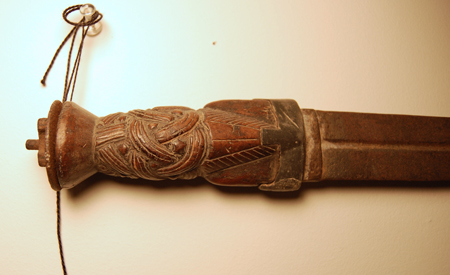
 Attachment: 121.26 KB Attachment: 121.26 KB
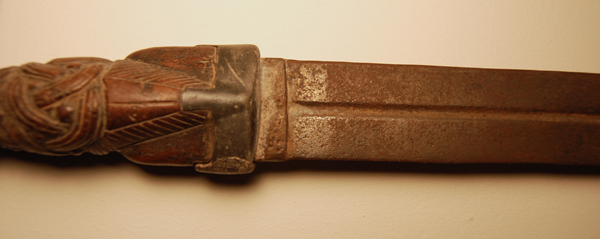
 Attachment: 109.99 KB Attachment: 109.99 KB
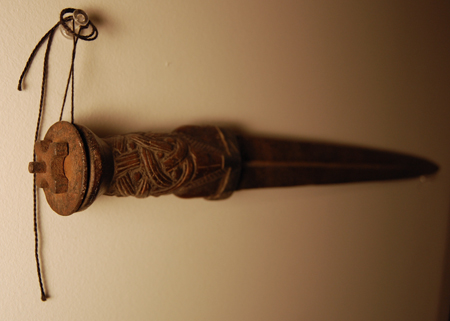
 Attachment: 148.46 KB Attachment: 148.46 KB
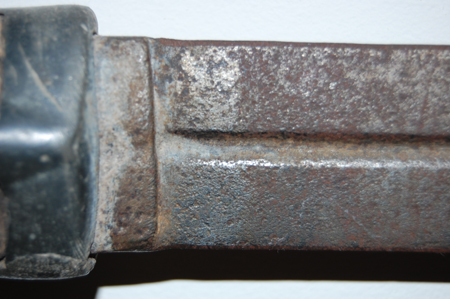
 Attachment: 107.57 KB Attachment: 107.57 KB
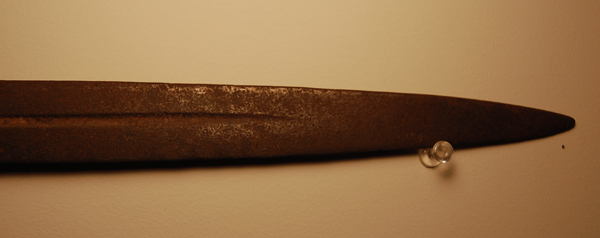
|
|
   |
 |
David Wilson

Location: In a van down by the river Joined: 23 Aug 2003
Posts: 803
|
 Posted: Wed 26 May, 2010 1:42 pm Post subject: Posted: Wed 26 May, 2010 1:42 pm Post subject: |
 |
|
Is it double-edged? If so, it's very unusual. Not unheard of, but very unusual.
The blade may be a cut down sword blade, but I'm leaning toward it being a purpose-built dagger blade someone had mounted in a Scottish-dirk-style.
How old? I can't say.... the hilt looks like it could be from the 18th century, but I would not discount this as being a Victorian or Edwardian era "commercial" dirk.... further research is warranted....
David K. Wilson, Jr.
Laird of Glencoe
Now available on Amazon: Franklin Posner's "Suburban Vampire: A Tale of the Human Condition -- With Vampires" https://www.amazon.com/dp/B072N7Y591
|
|
   |
 |
|
Paul DiLena
Location: NY Joined: 25 May 2010
Posts: 4
|
 Posted: Wed 26 May, 2010 2:09 pm Post subject: Posted: Wed 26 May, 2010 2:09 pm Post subject: |
 |
|
It is most certainly a double edged blade. I also have some additional info on the other dirk that it was found with. The blade was marked with "Andrea Ferraria"....not sure if that is meaningful in anyway. If anyone else out there has any other pertinent info or knowledge it would be much appreciated. The more I research this knife....the more convoluted it seems to get....Ah the mysteries of our past.
Any idea how it could be ruled out as Victorian?
|
|
   |
 |
|
Lin Robinson
|
 Posted: Wed 26 May, 2010 4:30 pm Post subject: Posted: Wed 26 May, 2010 4:30 pm Post subject: |
 |
|
| Paul DiLena wrote: | It is most certainly a double edged blade. I also have some additional info on the other dirk that it was found with. The blade was marked with "Andrea Ferraria"....not sure if that is meaningful in anyway. If anyone else out there has any other pertinent info or knowledge it would be much appreciated. The more I research this knife....the more convoluted it seems to get....Ah the mysteries of our past.
Any idea how it could be ruled out as Victorian? |
It means that the blade is probably a cut down sword blade. I do think the hilt may be of Victorian origin. It certainly has some characteristics of that era. I would contact someone who is an expert in the field for an opinion. It would also be good to consider taking it to someone who can do the modest amount of cleaning and stabilizing that it probably needs. With antiques it is best to do the absolute minimum in that regard.
Nice piece over all.
Lin Robinson
"The best thing in life is to crush your enemies, see them driven before you and hear the lamentation of their women." Conan the Barbarian, 1982
|
|
  |
 |
|
|

